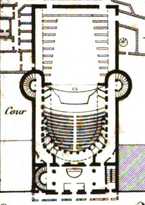Théâtre de la Gaîté
alias Grands-Danseurs du Roi (1772–1792), Théâtre de Nicolet (1759–1772)58 boulevard du Temple, | |
| show on the map |
Important events
History
"The site of this theatre is upon the boulevard du Temple, on part of the city ditch filled up by order of Louis XIV. In 1808, it was rebuilt under the direction of M. Peyre. Its form is a parallelogram of one hundred and eighteen feet by fifty-six. The front, which is quite plain, being decorated only with ornamental joints, is pierced with five arched windows, above which are an entablature and an attic. The form of the interior is square towards the stage and semicircular in the opposite direction. It contains three tiers of boxes, exclusive of the baignoires. The two upper tiers are supported by light pillars, and a third row of pillars supports the ceiling. The proscenium is decorated with four heavy pilasters, bearing an entablature and an attic.
The interior is painted to imitate yellow marble, and the ornaments are grey. The first tier of boxes is decorated with dramatic subjects painted in cameos; the second with masks and cornucopia; and the third with garlands and musical instruments, interspersed with helmets, swords, etc. The proscenium is rich and well composed. The ceiling is ornamented in arabesques. The curtain is a plain blue drapery in ample folds. The whole of this decoration, executed in 1816, by Messrs. Besnard and Bas-signy, has an agreeable effect. "
In: Whittaker, G. B.: The History of Paris from the Earliest Period to the Present Day: Vol. II. London, 1825 p. 521
Author: G. B Whittaker
G. B Whittaker:
Comédie-Française, Salle Richelieu, Théâtre de Variétés, Conservatoire National Supérieur d'Art Dramatique, Théâtre du Gymnase - Marie Bell, Theatre of the Comic-Ambiguity, Théâtre de la Porte Saint-Martin, Théâtre national de l'Opéra-Comique, Petit Bourbon, Odéon - Théâtre de l'Europe, Théâtre Feydeau, Cirque-Olympique in Mont Thabor Street, Salle des Machines, Theatre of Young Artists, Second Théâtre du Marais, Théâtre de la Gaîté, Théâtre National de la rue de la Loi, Salle Le Peletier, Panorama-Dramatique, Théâtre Louvois, Le Cirque-Olympique, Théâtre de la Société Olympique, Théâtre de la MolièreAdditional information
No information has yet been entered
Add information








